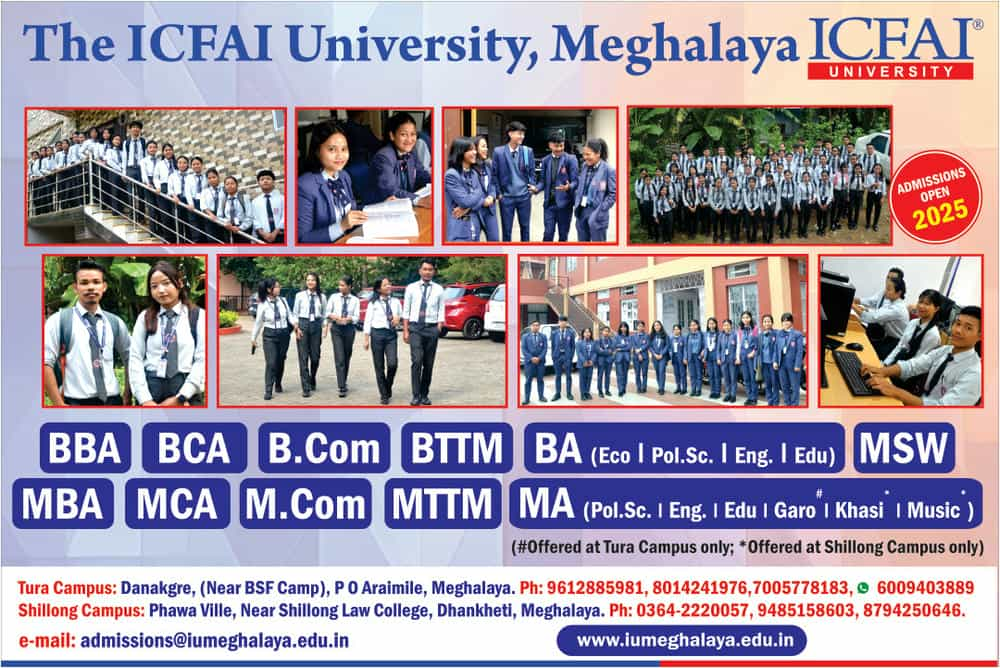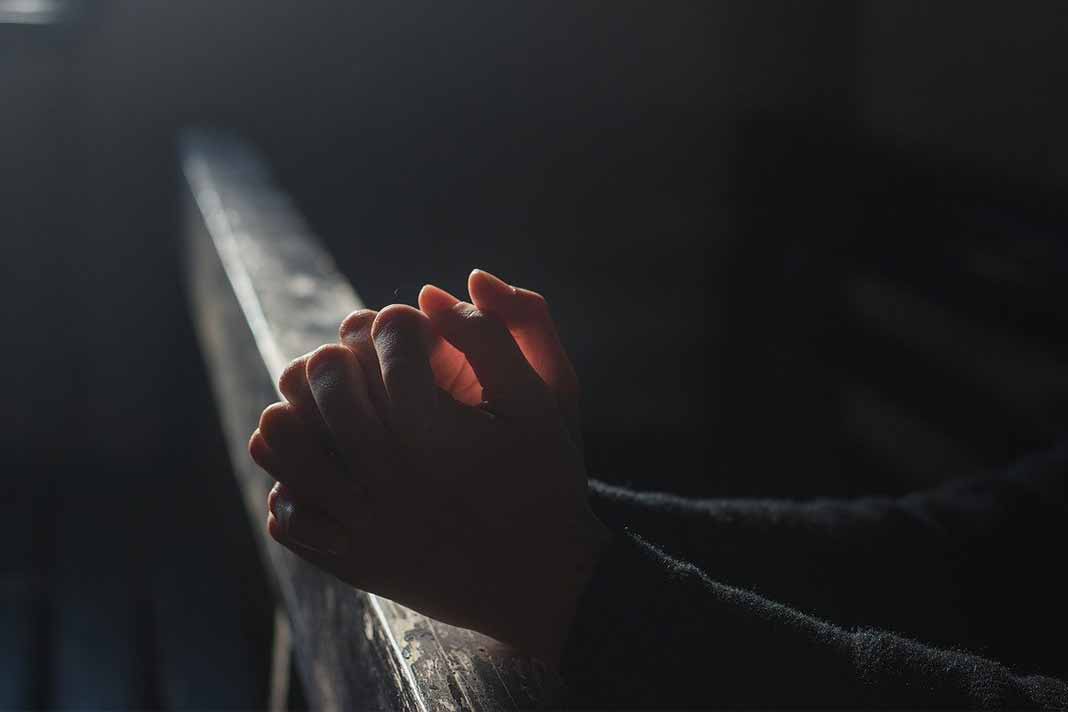Meghalaya issues SOP’s for religious places

Meghalaya Government on Friday issued SOP on preventive measures to contain spread of COVID-19 in religious places/places of worship.
An order issued by Chief Secreatary, Government of Meghalaya MS Rao said after due consultative meetings with various stakeholders, the following SOP is hereby notified:
I. Scope
Religious places/places of worship get frequented by large number of people for spiritual solace. To prevent spread of COVID-19 infection, it is important that required social distancing and other preventive measures are followed in such premises.
This document outlines various generic precautionary measures to be adopted in addition to specific measures to be taken at particular places to prevent spread of COVID-19.
Religious places/places of worship for public in containment zones shall remain closed. Only those outside containment zones will be allowed to open.
II. Generic preventive measures
Person above 65 years of age, persons with comorbidities, pregnant woman and children below the age of 10 years are advised to stay at home. Organisations managing the religious institutions to advise accordingly.
The generic preventive measures include simple public health measures that are to be followed to reduce the risk of COVID-19. These measures need to be observed by all (workers and visitors) in these places at all times.
These include:
1) Social Distancing is compulsory and individuals must maintain a minimum distance of 5 feet in public places as far as feasible.
2) Use of face covers/masks to be mandatory.
3) Practice frequent hand washing with soap (for at least 40-60 seconds) even when hands are not visibly dirty. Use of alcohol-based hand sanitizers (for at least 20 seconds) can be made wherever feasible.
4) Respiratory etiquettes to be strictly followed. This involves strict practice of covering one’s mouth and nose while coughing/sneezing with a tissue/handkerchief/flexed elbow and disposing off used tissues properly.
5) Self-monitoring of health by all and reporting any illness at the earliest to state and district helpline.
6) Spitting should be strictly prohibited.
7) Installation & use of Aarogya Setu App may be advised to all.
III. All religious places shall also ensure:
1) Entrance to have mandatory hand hygine (sanitizer disprnser) or hand washing and thermal screening provisions.
The religious organizations may place their respective requisition for thermal scanners with the District Medical and Health Officer, Health and Family Welfare Department, Government of Meghalaya who will make the thermal scanners available on payment basis.
2) Only asymptomatic persons to be allowed in the premises.
3) All persons to be allowed entry only if using face cover/masks.
4) Posters/standees on preventive measures about COVID-19 to be displayed prominently in both English and Local Language. The Health and Family Welfare Department, Government of Meghalaya will make available such IEC material. Audio and Video clips to spread awareness on preventive measures for COVID-19 should be regularly played.
5) Staggering of visitors to be done to the extent possible. For staggering to be effective, churches can have multiple services on any day. The duration of the service should be restricted to the minimum but should not normally exceed one hour. Similarly, staggering to be done for other places of religious worship.
At the completion of the services or worship, any form of socializing and meeting in groups in common areas within the premises of the place of worship/organization is prohibited.
6) Shoes/ footwear to be preferably taken off inside own vehicle. If needed they should be kept in separate slots for each individual/ family by the persons themselves. Alternatively, provision should be made for placing a disinfectant tray at the entrance to sanitize the shoes. People should wash their hand and feet with soap and water before entering the premises. In case of churches, shoes may be permitted provided provision is available for placing a disinfectant tray at the entrance to sanitize the shoes.
7) Proper crowd management in the parking lots and outside the premises duly following social distancing norms shall be organized.
8) Any shops, stalls, cafeteria etc., outside and within the premises shall follow social distancing norms at all times
9) Specific markings may be made with sufficient distance to manage the queue and ensure social distancing in the premises.
10) Preferably separate entry and exits shall be organized.
11) Maintain physical distancing of a minimum of 5 feet at all times when queuing up for entry.
12) Seating arrangement to be made in such a way that adequate social distancing is maintained.
As far as Churches are concerned, maximum number of persons allowed during any church service should not exceed one-third of the seating capacity of the church. Further, one row in between two pews should be left empty. Individuals should also maintain a minimum distance of 5 feet.
In Mosques, individuals must maintain a minimum distance of 5 feet.
In Temples, Gurudwaras and other religious places of worship, individuals must maintain a minimum distance of 5 feet.
Similarly, for prayers in mosques / temples/ other places of worship, the number of persons should not exceed one-third of the seating capacity of the place of worship.
Inside the place of worship, members of the same family are advised and encouraged to sit together.
13) Rites of initiation, which include prayers and ablutions relating to Births, Naming Ceremonies, Christening and Baptism, Bhogs, Installation and Ordination, other
respective rites and customs etc. are permitted at places of worship. Rites of induction, which include ceremonies of acceptance of a person into a full membership of the
respective faith community like confirmations, taking of the first communion, and others are permitted in places of worship. These are subject to:
(a) The number of candidates, celebrants, and ceremonies would be determined by the space and size of the place of worship and limited to one-third the seating capacity of the place of worship.
(b) Elements needed for these specific services are left to the discretion of each group as applicable and relevant to their practices.
(c)The communication and distribution of these elements should be done without any physical contact.
14) Marriage Ritual in places of worship is permitted, subject to:
The total number of persons (bride and groom, family members, celebrants, etc.) including invitees should not exceed one-third the seating capacity of the place of worship.
15) Rites of passage which include deaths and burials, funerals and cremations are permitted subject:
(a) The total number of persons attending the funeral service would be determined by the space and size of the place of worship and limited to one-third the seating capacity of the place of worship.
(b) There will be no procession to the Cemetery or Crematorium, and the number allowed would be regulated by the Dorbar Shnongs/ Welfare Societies and Graveyard Committees or Management of the Crematoria.
16) The names of the persons attending the place of worship should be maintained by the organization or faith group concerned and to be shared with the concerned Deputy Commissioner for contact tracing, if and when required.
17) For air-conditioning/ventilation, the guidelines of CPWD shall be followed which inter alia emphasises that the temperature setting of all air conditioning devices should be in the range of 24-30ºC, relative humidity should be in the range of 40-70%, intake of fresh air should be as much as possible and cross ventilation should be adequate.
18) Touching of statues/idols / holy books etc. not to be allowed. For Churches, persons may bring their hymn books and Bibles and sharing should be avoided.
Where the use of a common item in the worship hall is unavoidable, the item should be used with sanitized and gloved hands, and be kept from extensive use by many.
19) In view of potential threat of spread of infection, as far as feasible recorded devotional music/songs may be played and choir or singing groups should not be allowed. In churches, even while singing hymns masks should be worn at all times.
20) Avoid physical contact while greeting each other.
21) Common prayer mats should be avoided and devotees should bring their own prayer mat or piece of cloth which they may take back with them.
22) No physical offerings like Prasad/distribution or sprinkling of holy water, etc.to be allowed inside the religious place. During Holy Communion in Churches, Priest/Pastor/Person who administers the Holy Communion should wash and sanitize their hands, and wear gloves if feasible, before administering the Holy Communion and to further ensure that there is no physical contact with the communicants. Offerings and collections in places of worship should be made without physical contact.
23) Community kitchens/langars / “Ann-daan”, etc. at religious places should follow physical distancing norms while preparing and distributing food.
24) Sanitization of the place of worship should be done regularly, which shall be the responsibility of the organization or faith group. Effective sanitation within the premises shall be maintained with particular focus on lavatories, hand and foot-washing stations/areas.
25) Frequent cleaning and disinfection to be maintained by the management of the religious place.
26) As far as feasible, the floors should particularly be cleaned multiple times in the premises.
27) Proper disposal of face covers/ masks/ gloves left over by visitors and/or employees should be ensured.
28) As far as practicable, live streaming of services, prayers and other rituals can be adopted by all religious organisations to cater to elder people, children and persons with co-morbidities.
29) As far as practicable, persons should attend the place of worship that is nearest to their place of residence. This is to avoid unnecessary movement of persons.
30) In case of a suspect or confirmed case in the premises:
(a) Place the ill person in a room or area where they are isolated from others.
(b) Provide a mask/face cover till such time he/she is examined by a doctor.
(c)Immediately inform the nearest medical facility (hospital/clinic) or call the state or district helpline.
(d) A risk assessment will be undertaken by the designated public health authority (district RRT/treating physician) and accordingly further action be initiated regarding management of case, his/her contacts and need for disinfection.
(e) Disinfection of the premises to be taken up if the person is found positive.
IV. Events/Practices/Rituals/ Celebrations that are Periodic, Seasonal and Annual.
There are other practices in the calendar of each faith group which are periodic, seasonal and annual in nature. Most of these relate to activities which concern large crowds in assemblage and participation, as well as in community feasts and community activities. Some of these are also observed as Public Holidays.
For these activities, as large gatherings/congregation continue to remain prohibited, the concerned faith group should get the permission from the Government through the Deputy Commissioner concermed on a case-by-case basis.
These should not be clubbed with the regular daily or weekly practices and ceremonies in the places of worship.

Leave a Reply